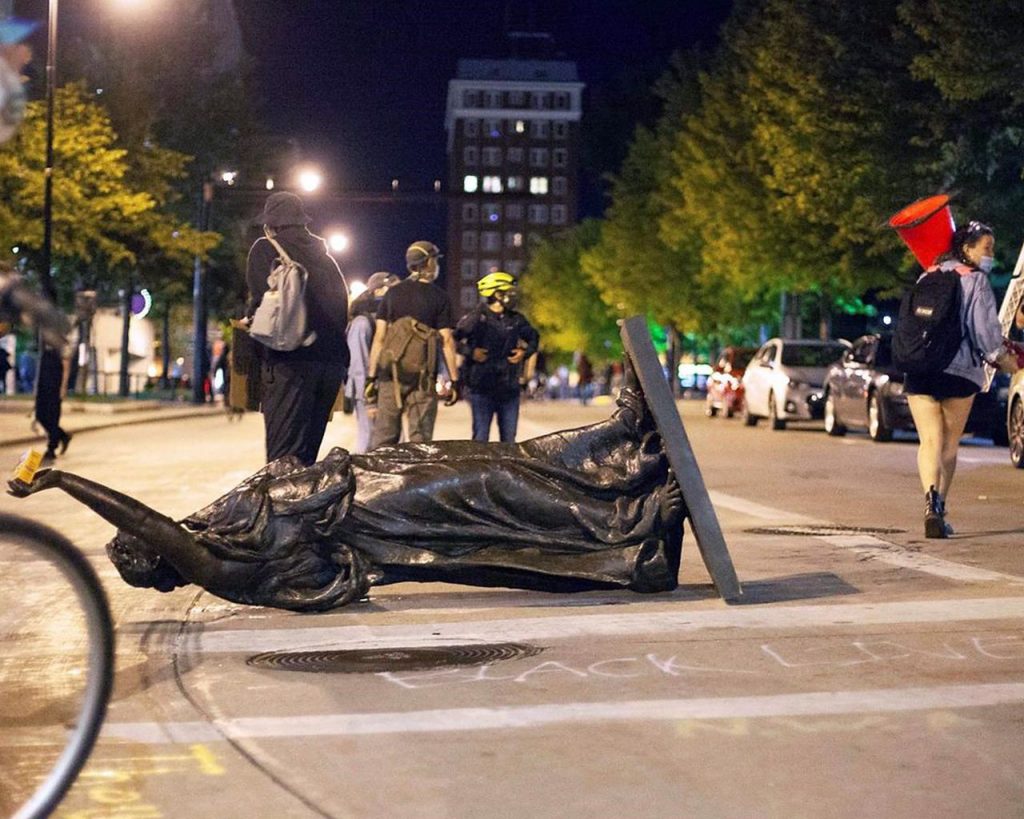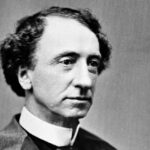Blog Post
Stop tearing down statues. Start putting more up.
By Jonathon Van Maren
This column was first published at The Stream
When the mobs came for the Confederate generals, most of us shrugged. Who wanted to defend the Confederacy? More to the point, who wanted to defend dead men and bad causes? It was not a hill worth dying on. There were other hills and other statues. And as it turned out, the mob was heading in that direction next.
I think we all knew that the smashing would continue. Cancel culture is an insatiable beast, and if radical feminists can get canceled, what chance did Christopher Columbus have? Or Winston Churchill, boxed up in London like a discarded decoration? Or the Abraham Lincoln statue vandalized nearby? Or George Washington, who was toppled and set alight with a burning American flag?
Robert E. Lee had to go because he fought to defend slavery. U.S. Grant, the man who beat him, was torn down because … because maybe this isn’t about past sins, after all. This is about rage, iconoclasm and revolution. One indicator is the selectiveness of the smashing. Margaret Sanger stayed up. Roosevelt’s statue at the Natural History Museum is coming down. Not the Roosevelt who opened internment camps for Japanese-Americans, mind you. The other one.
A statue of Hans Christian Heg near the Capitol, an anti-slavery activist and member of an anti-slavery militia, was also torn down. Protesters are also agitating for the destruction of the Emancipation Monument, featuring Lincoln and several freed slaves. It was built with donations from former slaves, dedicated on the 11th anniversary of Lincoln’s death by Frederick Douglass. 25,000 people attended the dedication. The protesters feel it is too “paternalistic.” They don’t see the irony of invalidating the sentiments of former slaves.
It may be that all common ground has vanished, and that the only thing left to do is to keep the barbarians away from the Lincoln Memorial. But perhaps there are just a few people left who might consider a different solution to all of this. Perhaps instead of tearing statues down, we could launch an initiative to put more up. Granted, building is harder than bashing. But there are many great Americans that deserve to be remembered. And remembering them would help to remind us of what America is all about.
For example, to my knowledge there is currently only one statue of Phillis Wheatley — in Boston. Wheatley is both exceptional and unknown to most Americans. Although she died 11 years after her emancipation in 1784 at the young age of 31, Wheatley achieved the distinction of being the first African American female poet to be published in America. Born in West Africa and sold into slavery in the 1760s, she later became a Christian. Her Christianity was often the subject of her poems (which numbered around 145).
As historian Thomas Kidd recently noted, Wheatley powerfully condemned slavery — while writing her most well-known poem about a slave owner. Her 1770 “An Elegiac Poem, on the Death of that Celebrated Divine, and Eminent Servant of Jesus Christ, George Whitefield” paid tribute to the great evangelist. It reads in part:
Hail, happy Saint, on thy immortal throne!
To thee complaints of grievance are unknown;
We hear no more the music of thy tongue,
Thy wonted auditories cease to throng.
Thy lessons in unequal’d accents flow’d!
While emulation in each bosom glow’d;
Thou didst, in strains of eloquence refin’d,
Inflame the soul, and captivate the mind.
Unhappy we, the setting Sun deplore!
Which once was splendid, but it shines no more;
He leaves this earth for Heav’n’s unmeasur’d height,
And worlds unknown, receive him from our sight;
There Whitefield wings, with rapid course his way,
And sails to Zion, through vast seas of day.
Wheatley’s work was magnificent. With a few more statues of her around, perhaps we could do a better job of remembering her.
If a statue of William Still exists, I cannot find it. Born in Burlington Country, New Jersey in 1821, Still became one of America’s most prominent abolitionists. His father and mother had both been slaves. In 1844, Still moved to Philadelphia. In 1847, Still began working as a clerk for the Pennsylvania Society for the Abolition of Slavery. He aided escaped slaves, often giving them shelter as they made their way north. One turned out to be his older brother Peter. His mother had been forced to leave him behind when she escaped 40 years earlier. Still’s 1872 book The Underground Railroad, based on his records and reminiscences, is one of the most important historical documents we possess. While recognizing the many white abolitionists, Still noted the sterling courage of the slaves who struggled for their own freedom.
Still helped at least 800 slaves escape to freedom. (He purportedly paid for some of Harriet Tubman’s missions, too.) He also gave us an essential history, and spent his adult life agitating for the rights of African Americans. Still fought for voting rights, against segregation and eventually for universal suffrage. He was also a temperance advocate and set up a mission Sabbath School for the Presbyterian Church.
Perhaps a few statues of Still could induce a few Americans to read his essential book. That alone would be worth the price.
Harriet Tubman is one of the few figures of this period that is receiving her due. Nine statues of Tubman have been set up across the US. I would like to propose that a Tubman statue be set up in Washington, DC as well. She is, without doubt, one of the greatest figures in American history. In 1849, she made the 90-mile trek from Maryland to Philadelphia — alone. Then, against all advice, she headed back. Between 1850 and 1860 Tubman returned to the South at least 13 times. She guided at least 80 slaves to freedom. Among them were her siblings and her parents. Some say she guided hundreds. As a conductor on the Underground Railroad, she never lost a passenger. She became known as the “Moses” of her people.
Her Christian faith made Tubman fearless. “Great fears were entertained for her safety, but she seemed wholly devoid of personal fear,” Still marveled. “The idea of being captured by slave hunters or slave holders never seemed to enter her mind. She was apparently proof against all adversaries.” When the Civil War began, Tubman became a spy for the Union Army. At one point, she led three Union steamboats around Confederate landmines in the Combahee River. Several plantations were destroyed and 750 slaves were freed. Tubman became the only woman to lead men into combat during the Civil War.
Every step of the way, Tubman believed that God was leading her. “I always tole God, ‘I’m gwine [going] to hole stiddy on you, an’ you’ve got to see me through,” she said later. As abolitionist Thomas Garrett said: “I never met nay person of color who had more confidence in the voice of God.”
There are several statues today of Frederick Douglass. I visited one of them in Rochester, New York earlier this year when I went to his gravesite. Douglass is nearly as well-known as Tubman, but more statues of this great man would help in promoting his work. His memoir, which I read at the age of 13, is simply stunning. His condemnation of the hypocrisy of white Christians is still chilling today:
We have men sold to build churches, women sold to support the gospel and babes sold to purchase Bibles for the poor heathen! All for the glory of God and the good of souls! The slave auctioneer’s bell and the church-going bell chime in with each other, and the bitter cries of the heart-broken slave are drowned in the religious shouts of his pious master. Revivals of religion and revivals of the slave trade go hand in hand.
After securing his freedom, Douglass became an abolitionist leader in Philadelphia. He was a pastor at the African Methodist Episcopal Zion Church. After his writing gained attention, he became a speaker for the Massachusetts Anti-Slavery Society. From 1847 to 1851 he published his own newspaper, The North Star. He recruited for the Massachusetts 54th regiment for the Union Army. These recruits included his own son. He met with Lincoln twice to discuss treatment of colored soldiers. For the rest of his life, he held a well-deserved prominence in freedom causes. His 1852 speech “What to the Slave is your Fourth of July?” is considered one of the greatest anti-slavery speeches ever written.
He predicted that slavery would end in war by quoting Isaiah to the crowd: “And when ye spread forth your hands, I will hide mine eyes from you: yea, when ye make many prayers, I will not hear: your hands are full of blood.”
And there are so many others that deserve to be remembered, abolitionists both black and white. The history of America is not only that of injustice and oppression. It is also of the fight for a better union and the better angels of our nature. I could list dozens of great men and women who deserve our remembrance. But I suspect that these people, with their Christianity and their conviction and their courage, are not what the iconoclasts want. It is those values, in part, that they are rebelling against. Watching the scenes of destruction unfold across America, I was reminded of an observation by G.K. Chesterton in What’s Wrong with the World:
The modern mind is forced towards the future by a certain sense of fatigue, not unmixed with terror, with which it regards the past. It is propelled towards the coming time; it is, in the exact words of the popular phrase, knocked into the middle of next week. And the goad which drives it on thus eagerly is not an affectation for futurity. Futurity does not exist, because it is still future. Rather it is a fear of the past; a fear not merely of the evil in the past, but of the good in the past also. The brain breaks down under the unbearable virtue of mankind.
There have been so many flaming faiths that we cannot hold; so many harsh heroisms that we cannot imitate; so many great efforts of monumental building or of military glory which seem to us at once sublime and pathetic. The future is a refuge from the fierce competition of our forefathers. The older generation, not the younger, is knocking at our door … the future is a blank wall on which every man can write his own name as large as he likes; the past I find already covered with illegible scribbles, such as Plato, Isaiah, Shakespeare, Michelangelo, Napoleon. I can make the future as narrow as myself; the past is obliged to be as broad and turbulent as humanity. And the upshot of this modern attitude is really this: that men invent new ideals because they dare not attempt old ideals. They look forward with enthusiasm, because they are afraid to look back.”
But we must look back. The solution to this moment is not to smash everything down. We should be expanding the pantheon of heroes while recognizing that they were still sinful humans. And each statue should remind everyone of a sentiment expressed by the unparalleled Langston Hughes:
I, too, sing America.
I am the darker brother.
They send me to eat in the kitchen
When company comes,
But I laugh,
And eat well,
And grow strong.I’ll be at the table
When company comes.
Nobody’ll dare
Say to me,
“Eat in the kitchen,”
Then.Besides,
They’ll see how beautiful I am
And be ashamed —I , too, am America.








